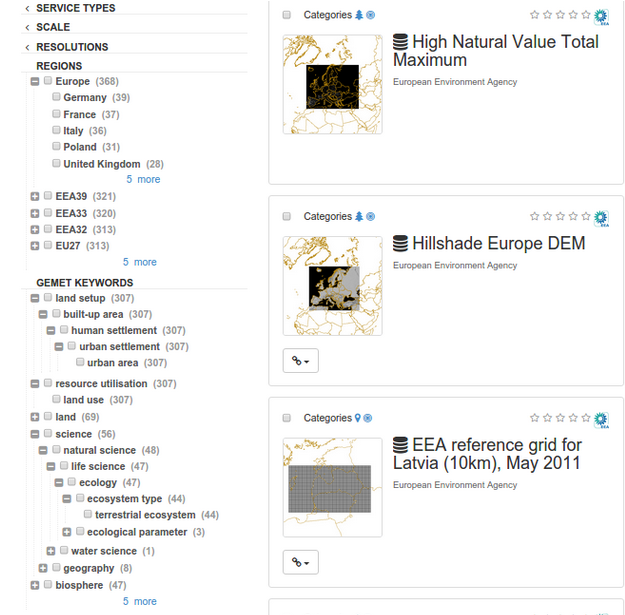Configuring facetted search¶
Facet principle¶
Faceted search provides a way to easily filter search.

2 types of facets exist:
- simple facet (only a list of value)
- hierarchical facet (a category tree of value) requiring a thesaurus with relations.
Facet response when searching¶
When running a search a resultType parameter define a set of facet to return.
A facet response looks like the following:
<response from="1" to="20" selected="0">
<summary count="134" type="local">
<dimension name="type" label="types">
<category value="dataset" label="Dataset" count="86"/>
<category value="series" label="Series" count="41"/>
<category value="service" label="Service" count="7"/>
</dimension>
<dimension name="denominator" label="denominators">
<category value="200000" label="200000" count="1"/>
<category value="50000" label="50000" count="1"/>
<category value="25000" label="25000" count="1"/>
<category value="15000" label="15000" count="4"/>
<category value="10000" label="10000" count="1"/>
<category value="5000" label="5000" count="3"/>
<category value="2000" label="2000" count="12"/>
</dimension>
<dimension name="resolution" label="resolutions">
<category value="5 m" label="5 m" count="10"/>
<category value="1 m" label="1 m" count="3"/>
<category value="0.20 m" label="0.20 m" count="1"/>
</dimension>
</summary>
User can retrieve a JSON response by adding _content_type=json in the parameter list.
Configuration¶
The facet configuration is done manually in WEB-INF/config-summary.xml. After change,
stop the application, drop the index and start the application to fully rebuild the index.
A facet is based on a field in the index (see Configuring search fields).
Each facet to be indexed is defined in the facets element. The facets element
lists the facets to index and how they should be indexed using attributes
on facet elements as follows:
- name: the name of the facet
- indexKey: the name of the indexing field to be used for the facet
- label: the label to use for the facet in returned summaries
- (optional) classifier: a reference to a spring bean that should be used to determine facet values for the indexing field. Used for hierarchical facets. The bean must implement the org.fao.kernel.search.classifier.Classifier interface Defaults to a classifier which uses the value of the field to be indexed
- localized: todo documentation
eg. for a simple facet
<facet name="denominator"
indexKey="denominator"
label="denominators"/>
eg. for a hierarchical facet based on a thesaurus.
- Define the facet
<facet name="gemetKeyword"
label="gemetKeywords"
indexKey="keyword"
classifier="gemetKeywordClassifier"/>
- Register the classifier in
WEB-INF/config-spring-geonetwork.xml
<bean id="gemetKeywordClassifier"
class="org.fao.geonet.kernel.search.classifier.TermLabel" lazy-init="true">
<constructor-arg name="finder" ref="ThesaurusManager"/>
<constructor-arg name="conceptScheme" value="http://geonetwork-opensource.org/gemet"/>
<constructor-arg name="langCode" value="eng"/>
</bean>
- Add the facet to a summary type (see below)
How facet summaries should be built and formatted for each summary type is defined
in the summaryTypes element. Create a new facet sets using:
<summaryTypes>
<summaryType name="details" format="DIMENSION">
The format attribute set to DIMENSION is the preferred format with a top level
dimension tag and category tags for sub-categories which is more suitable for hierarchical facets.
It also support one level facets.
Deprecated since version the: format FACET_NAME (still the default) was used for
generating facet summary elements using one level only. This mode is not recommended.
The summaryTypes element contains a number of summaryType elements each
of which define a facet summary that can be configured for a service.
Each summaryType element contains a list of facets (item) to be
returned and how they should be formatted as follows:
- facet: the name of a facet defined above
- (optional) sortBy: the ordering for the facet. Defaults to by count.
- (optional) sortOrder: asc or desc. Defaults is descendant.
- (optional) max: the number of values to be returned for the facet. Defaults to 10.
- (optional) depth: the depth to which hierarchical facets should be summarised. Defaults to 1.
- (optional) translator: Define a DB translator to retrieve label from description tables (eg. categoriesdes) or codelist translator to retrieve label from schema codelists files.
eg. for category
<item dimension="category"
plural="categories"
indexKey="_cat"
max="45"
translator="db:org.fao.geonet.repository.MetadataCategoryRepository:findOneByName"/>
or for group
<item dimension="groupOwner"
plural="groupOwners"
indexKey="_groupOwner"
max="99"
sortBy="value"
translator="db:org.fao.geonet.repository.GroupRepository:findOne:int"/>